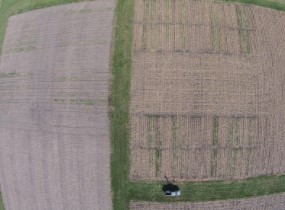By Eric Hamilton
Farmers around the world are keen to protect their most important asset: their soil. The soil supports and enriches their crops. But the relatively thin layer of topsoil can readily wash away into streams, carrying unwanted nutrients with it.

Aerial drone image showing two months of cover crop growth in Monmouth, Illinois in November, 2016.
Enter cover crops. Cover crops are inedible plants grown during the off-season. Their roots help keep soil in place, preventing erosion. Cover crops can even absorb excess nutrients like nitrogen to keep them from polluting streams. Farmers are increasingly interested in using cover crops to help their farms. But with a dizzying array of plants to choose from and complex crop rotations, making the right choice is no easy feat.
“I believe cover crops are a very important tool for both retaining soil and keeping nutrients on the farm,” says María Villamil, a researcher at the University of Illinois and a member of the American Society of Agronomy. “In the Midwest, we are very lucky to have high fertility soils, making us big providers of food worldwide. The protection of our soils is critical.”
To help farmers in Illinois choose the right cover crop, Villamil and her team decided to test several potential cover crops. They planted different cover crops between the common Midwestern rotation of corn and soybeans. The researchers worked closely with farmers to choose which cover crops to test.
“They wanted to test different cover crops, especially ones that don’t generate extra work in the spring and others that will not compete with the corn for resources,” says Villamil.
Farmers preferred growing cereal rye as a cover crop before soybeans were planted. The rye captured the nitrogen remaining in the soil after the previous year's corn crop season. But, when farmers were planning to grow corn, they preferred using a vetch cover crop. Vetch is a legume crop, which means it can provide nitrogen for the corn to use later in the season. Vetch also uses less water than cereal rye, which means the corn crop will not need to work as hard to compete for limited water resources.

Cover crop growth in Urbana, Illinois in April following a mild winter shows strong cereal rye and annual ryegrass growth.
Villamil’s team set up experimental plots at six locations around the state. Toward the end of the growing season for corn or soybeans, researchers walked through the crop fields to spread cover crop seeds among the plants. This mimics seeding by airplane. Aerial seeding has been a popular idea to plant cover crops in a timely manner over existing crops in fields. The cover crops they tested included spring oats, red clover, annual ryegrass and radishes, among others.
Then the researchers tracked how well the cover crops grew, how soil properties changed over time, and the yield of future food crops.
Surprisingly, the cover crops didn’t have a big effect on the soil. “There was not much improvement of the soil properties with using a cover crop, except for maybe the rotation using the annual ryegrass,” says Villamil.
The biggest reason most of the cover crops didn’t affect the soil very much is that most of them died over the winter. That’s largely because of the weather. Midwestern states like Illinois are subject to potentially harsh winters, especially in the northern part of the state. The broadcast seeding the researchers did also meant that the seeds simply sat on top of the soil. That meant the cover crops had a harder time germinating than if the seeds had been buried in the ground.
But cover crops that die over winter can be a good thing. Dead cover crops mean farmers will have less work killing them in the spring. But they’re also less effective at protecting the soil or absorbing nutrients.
Click here to see more...